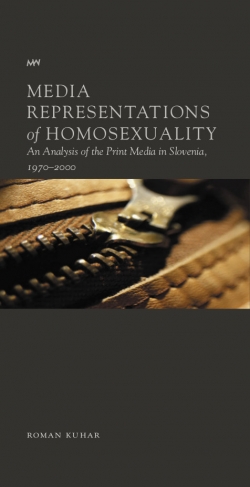Media Representation of Homosexuality. An Analysis of the Print Media in Slovenia, 1970 – 2000

Book Stores
Type
Book
Authors
Category
Publication Year
2003
Publisher
Pages
112
Description
The subject of this study is media construction of homosexuality. The author looks into the media representations of homosexuals and related discourse on homosexuality in the print media in Slovenia in the period 1970-2000. The author places these media texts into their historical context and presents an overview of the history of gay and lesbian movement in Slovenia.
Media representations of homosexuality are divided into five basic categories: stereotyping, medicalization, sexualization, secrecy and normalization. Stereotyping primarily relies on rigid gender schemas exploited by the media to present gays as effeminate and lesbians as masculine, drawing on the analogy with their social roles which thus appear as natural rather than socially constructed. Medicalization of homosexuality is a continuation of the psychiatric discourse on same-sex orientation from the end of the 19th century. In media representations it is manifested as a search for the causes of homosexuality (the implied question is “what went wrong and led to homosexuality?”) and the consigning of homosexuality to the medical and psychiatric spheres (homosexuality as a disease or a disorder). Sexualization, the third component of the media discourse, is manifested as a reduction of homosexuality solely to sexuality and sex (since sexualization frequently occurs in graphic images, the author uses Barthes’ model to explain the difference between the connotative and denotative levels). The veil of secrecy implied by media representations makes homosexuality appear as something concealed and related to shame and regret. Normalization, the last component of media representations, is characteristic primarily of the late 1990s when previous images of homosexuals as criminals, psychiatric patients and the like, were surpassed. However, this change in attitude is only apparent, since the kind of normalization found in media representations is actually a heterosexual normalization. Media representations of normal homosexuality are representations tailored to the perception of heterosexuals in such a way that they do not threaten their world. Homosexuality is acceptable only when depoliticized.
The author concludes that in the period 1970-2000 media reporting on homosexuality was generally sympathetic or neutral. Yet this general positive trend within media representations nevertheless contains ingredients that enable the perpetuation of the negative attitude of public opinion towards this phenomenon. The author argues that it is precisely the five most frequent components of media representations mentioned above that are responsible for the gap between politically correct media representations and negative public opinion. Homosexuality still causes uncertainty and uneasiness, so the media usually resort to highly stereotyped images which easily tally with the readers’ representations of homosexuality without upsetting them.
Media representations of homosexuality are divided into five basic categories: stereotyping, medicalization, sexualization, secrecy and normalization. Stereotyping primarily relies on rigid gender schemas exploited by the media to present gays as effeminate and lesbians as masculine, drawing on the analogy with their social roles which thus appear as natural rather than socially constructed. Medicalization of homosexuality is a continuation of the psychiatric discourse on same-sex orientation from the end of the 19th century. In media representations it is manifested as a search for the causes of homosexuality (the implied question is “what went wrong and led to homosexuality?”) and the consigning of homosexuality to the medical and psychiatric spheres (homosexuality as a disease or a disorder). Sexualization, the third component of the media discourse, is manifested as a reduction of homosexuality solely to sexuality and sex (since sexualization frequently occurs in graphic images, the author uses Barthes’ model to explain the difference between the connotative and denotative levels). The veil of secrecy implied by media representations makes homosexuality appear as something concealed and related to shame and regret. Normalization, the last component of media representations, is characteristic primarily of the late 1990s when previous images of homosexuals as criminals, psychiatric patients and the like, were surpassed. However, this change in attitude is only apparent, since the kind of normalization found in media representations is actually a heterosexual normalization. Media representations of normal homosexuality are representations tailored to the perception of heterosexuals in such a way that they do not threaten their world. Homosexuality is acceptable only when depoliticized.
The author concludes that in the period 1970-2000 media reporting on homosexuality was generally sympathetic or neutral. Yet this general positive trend within media representations nevertheless contains ingredients that enable the perpetuation of the negative attitude of public opinion towards this phenomenon. The author argues that it is precisely the five most frequent components of media representations mentioned above that are responsible for the gap between politically correct media representations and negative public opinion. Homosexuality still causes uncertainty and uneasiness, so the media usually resort to highly stereotyped images which easily tally with the readers’ representations of homosexuality without upsetting them.
Number of Copies
1
| Library | Accession No | Call No | Copy No | Edition | Location | Availability |
|---|---|---|---|---|---|---|
| Main | 316 | 1 | Yes |




